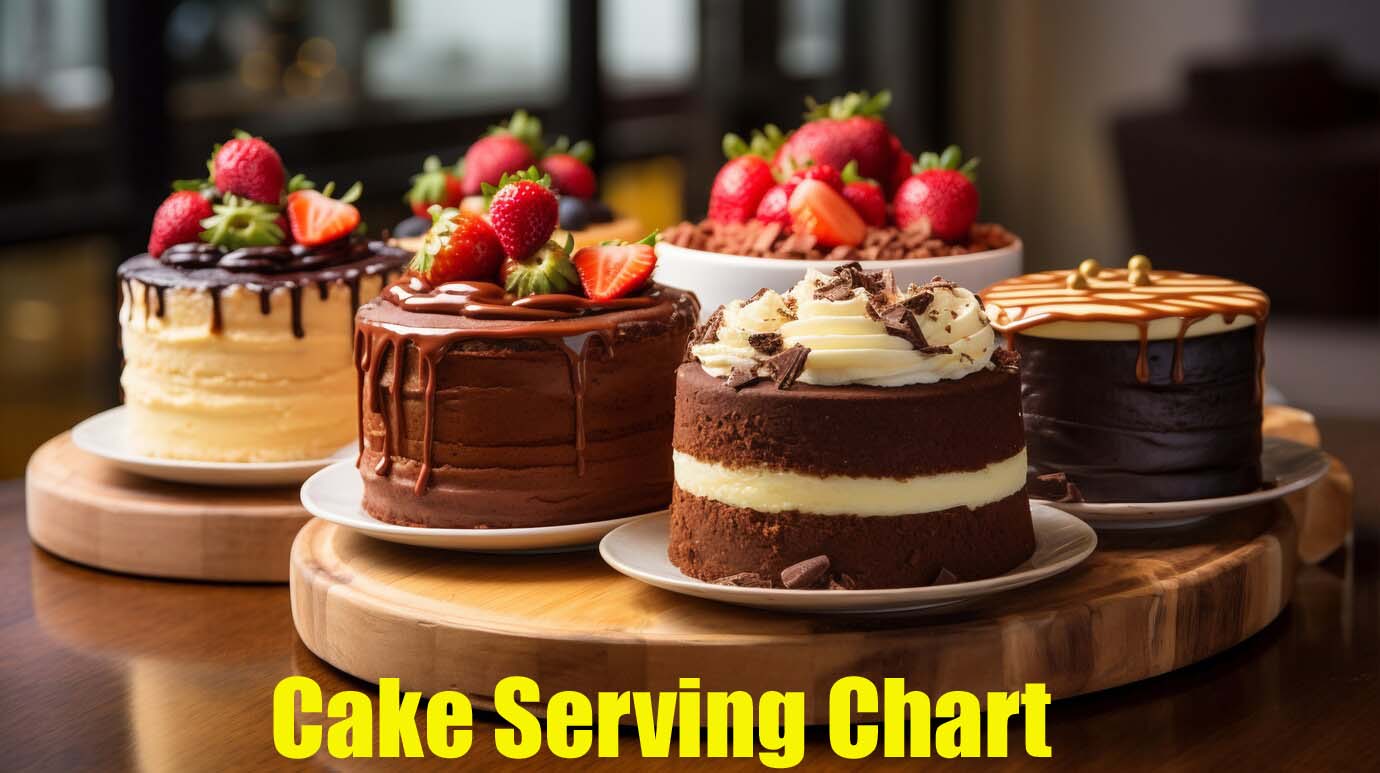Introduction
When it comes to celebrating special occasions, a cake often takes center stage. But one question always arises: how much cake do you need? Enter the cake serving chart—a handy guide that helps you determine how many servings you can get from various cake sizes and shapes. Understanding and utilizing a cake serving chart ensures that every guest gets a piece and that you avoid the common pitfalls of overestimating or underestimating the amount of cake needed.
Understanding Cake Serving Sizes
Standard Serving Sizes
Standard cake serving sizes are typically measured in inches per slice. A standard slice is usually considered to be about 1 inch by 2 inches for party cakes, or 1 inch by 1 inch for wedding cakes. However, these sizes can vary based on personal preference and the type of event.
Factors Influencing Serving Sizes
Several factors can influence how many servings you get from a cake:
- Type of Event: Casual parties might have larger servings compared to formal events.
- Cake Design: Cakes with multiple layers or intricate designs might yield fewer servings.
- Guest Preferences: Knowing your guests’ preferences can help in deciding serving sizes.
Types of Cakes and Their Serving Sizes
Round Cakes
Round cakes are popular for many occasions due to their classic shape and versatility. Here’s a breakdown of serving sizes for different diameters:
6-inch Round Cake
A 6-inch round cake typically serves 8-12 people, depending on how generously you slice it.
8-inch Round Cake
An 8-inch round cake can serve about 15-20 people, making it a great choice for medium-sized gatherings.
10-inch Round Cake
A 10-inch round cake serves approximately 25-30 people, ideal for larger parties.
Square Cakes
Square cakes provide more servings than round cakes of the same size due to their corners.
6-inch Square Cake
A 6-inch square cake can serve around 12-18 people.
8-inch Square Cake
An 8-inch square cake serves about 20-32 people.
10-inch Square Cake
A 10-inch square cake can serve approximately 30-50 people.
Rectangular Cakes
Rectangular cakes are often used for larger events and come in various sizes.
Half Sheet Cake
A half sheet cake serves about 50-60 people, making it perfect for big celebrations.
Full Sheet Cake
A full sheet cake serves around 100-120 people, ideal for very large gatherings.
Cake Tiers and Their Impact on Servings
Single-Tier Cakes
Single-tier cakes are straightforward and easier to serve. The serving size depends on the diameter and height of the cake.
Two-Tier Cakes
Two-tier cakes add elegance and can serve more people. For example, an 8-inch tier combined with a 6-inch tier can serve approximately 35-45 people.
Multi-Tier Cakes
Multi-tier cakes are perfect for weddings and large events. A common three-tier cake (10-inch, 8-inch, and 6-inch) can serve around 75-100 people.
How to Use a Cake Serving Chart
Reading the Chart
To use a cake serving chart, simply find the size and shape of your cake and look at the corresponding serving size. Most charts are organized by cake shape and size.
Adjusting for Different Occasions
Adjust the serving sizes based on the event type. For example, you might serve smaller slices at a wedding and larger slices at a birthday party.
Creating Your Own Cake Serving Chart
Measuring Your Cake
Start by measuring the diameter and height of your cake. Use a ruler or a cake guide to get accurate measurements.
Calculating Servings
Use the standard serving size guidelines to calculate how many servings your cake will provide. For example, a 1-inch by 2-inch slice for a party cake or a 1-inch by 1-inch slice for a wedding cake.
Tips for Cutting Cakes
Tools You Need
Having the right tools is essential for cutting cakes. You’ll need a long, sharp knife, a cake server, and possibly a ruler to guide your cuts.
Cutting Techniques for Different Shapes
- Round Cakes: Cut a circle in the center and then make slices outward.
- Square Cakes: Make grid-like cuts for even slices.
- Rectangular Cakes: Use long, even cuts to maximize servings.
Special Considerations
Dietary Restrictions
Always consider dietary restrictions such as allergies or preferences (gluten-free, vegan, etc.) and have alternative options if needed.
Event Types (Weddings, Birthdays, etc.)
Different events may require different cake types and serving sizes. Wedding cakes often have smaller slices, while birthday cakes might have larger ones.
Visual Aids in Cake Serving Charts
Diagrams and Illustrations
Visual aids such as diagrams can help you understand serving sizes better. Many charts include pictures showing how to cut the cake.
Using Technology for Better Visuals
Apps and online tools can provide interactive cake serving charts, making it easier to adjust sizes and servings.
Common Mistakes and How to Avoid Them
Overestimating Servings
Overestimating can lead to unnecessary leftovers. Stick to the serving chart guidelines to avoid this.
Underestimating Servings
Underestimating can leave guests without cake. Always err on the side of caution and make a bit more than you think you need.
Case Studies
Real-life Examples of Cake Serving Charts
Reviewing real-life examples can provide practical insights into using cake serving charts effectively. Many bakers share their experiences online, which can be very helpful.
Resources for Further Reading
Books and Websites
Look for books on cake baking and serving, as well as reputable websites that offer free resources and tips.
Tools and Apps
Explore tools and apps designed to help with cake serving charts. These can offer interactive features to make the process easier.
Conclusion
A cake serving chart is an invaluable tool for any baker or event planner. It ensures that everyone gets a piece and helps you plan accurately. By understanding serving sizes, types of cakes, and how to cut them, you can make your event a sweet success.
FAQs
How do I know what size cake to make?
Consider the number of guests and use a cake serving chart to determine the size. Always make a bit more to be safe.
Can I make a cake serving chart for cupcakes?
Yes, you can create a chart for cupcakes by considering each cupcake as a single serving. Adjust based on guest count.
What is the best way to store leftover cake?
Store leftover cake in an airtight container in the refrigerator. For longer storage, wrap it tightly and freeze.
How do I transport a multi-tiered cake?
Use cake dowels for support and a sturdy box. Drive slowly and keep the cake level during transport.
Are there any apps that help with cake serving charts?
Yes, several apps and online tools are available that provide interactive cake serving charts. They can help you adjust serving sizes and visualize cuts.
What if I Have More Guests than Expected?
If more guests show up, you can cut smaller slices or have an additional backup cake.
Can I Use the Same Chart for All Cake Types?
Generally, yes. However, some cakes like ice cream cakes might require different serving sizes.
How Do I Adjust for Extra Layers or Fillings?
Extra layers or fillings can change the serving size. Consider these when calculating servings and adjust accordingly.











